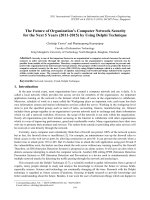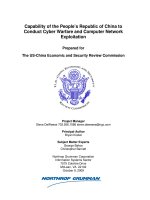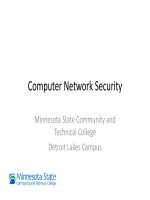computer network english slide
Bạn đang xem bản rút gọn của tài liệu. Xem và tải ngay bản đầy đủ của tài liệu tại đây (626.23 KB, 39 trang )
Computer Networks
2
Chapter Goals
•
Describe the core issues related to computer
networks
•
List various types of networks and their
characteristics
•
Explain various topologies of local-area networks
•
Explain why network technologies are best
implemented as open systems
•
Compare and contrast various technologies
for home Internet connections
3
Chapter Goals
•
Explain packet switching
•
Describe the basic roles of various network
protocols
•
Explain the role of a firewall
•
Compare and contrast network hostnames and
IP addresses
•
Explain the domain name system
•
Describe cloud computing and its benefits
4
Networking
Computer network
A collection of computing devices connected in
order to communicate and share resources
Connections between computing devices can be
physical using wires or cables or wireless using
radio waves or infrared signals
Can you name some of the devices in a computer
network?
Can you name some of the devices in a computer
network?
5
Networking
Node (host)
Any device on a network
Data transfer rate (bandwidth)
The speed with which data is moved from one
place to another on a network
Why is bandwidth so key?
6
Networking
Computer networks have opened up an entire
frontier in the world of computing called the
client/server model
Figure 15.1 Client/Server interaction
7
Networking
Protocol
A set of rules that defines how data is formatted and
processed on a network; i.e., rules that allow client/server
interaction
File server
A computer that stores and manages files for multiple
users on a network
Web server
A computer dedicated to responding to requests (from the
browser client) for web pages
8
Types of Networks
Local-area network (LAN)
A network that connects a relatively small number of
machines in a relatively close geographical area
Ring topology connects all nodes in a closed loop
on which messages travel in one direction
Star topology centers around one node to which all
others are connected and through which all
messages are sent
Bus topology nodes are connected to a single
communication line that carries messages in both
directions
Types of Networks
Ethernet
The industry standard bus technology for
local-area networks
Figure 15.2 Various network topologies
10
Types of Networks
Wide-area network (WAN)
A network that connects local-area networks over a
potentially large geographic distance
Metropolitan-area network (MAN)
The communication infrastructures that have been
developed in and around large cities
Gateway
One particular set up to handle all communication going
between that LAN and other networks
11
Types of Networks
Figure 15.1 Local-area networks connected across a distance to create a wide-area
network
12
Types of Networks
Internet
A wide area network that spans the planet
So, who owns the Internet?
13
Internet Connections
Internet backbone
A set of high-speed networks that carry Internet
traffic, provided by companies such as AT&T,
Verizon, GTE, British Telecom, and IBM
Internet service provider (ISP)
A company that provides other companies or
individuals with access to the Internet
14
Internet Connections
Various technologies available to connect a home
computer to the Internet
Phone modem converts computer data into an analog
audio signal for transfer over a telephone line, and
then a modem at the destination converts it back again
into data
Digital subscriber line (DSL) uses regular copper
phone lines to transfer digital data to and from the
phone company’s central office
Cable modem uses the same line that your cable TV
signals come in on to transfer the data back and forth
15
Internet Connections
Broadband
A connection in which transfer speeds are faster
than 768 kilobits per second
–
DSL connections and cable modems are
broadband connections
–
The speed for downloads (getting data from the
Internet to your home computer) may not be the
same as uploads (sending data from your home
computer to the Internet)
Packet Switching
Packet
A unit of data sent across a network
Router
A network device that directs a packet between networks
toward its final destination
Packet switching
Messages are divided into fixed-sized, numbered packets;
packets are individually routed to their destination, then
reassembled
17
Packet Switching
Figure 15.4
Messages
sent by
packet
switching
Take a message, break it into three packets, and
simulate this process
18
Open Systems
A logical progression
Proprietary system
A system that uses technologies kept private by a
particular commercial vendor
Interoperability
The ability of software and hardware on multiple
machines and from multiple commercial vendors to
communicate
Open systems
Systems based on a common model of network
architecture and a suite of protocols used in its
implementation
19
Open Systems
Open Systems
Interconnection Reference
Model
A seven-layer logical break
down of network interaction to
facilitate communication
standards
Each layer deals with a
particular aspect of network
communication
Figure 15.5 The layers of the OSI Reference Model
20
Network Protocols
•
Network protocols are layered such that each
one relies on the protocols that underlie it
•
Sometimes referred to as a protocol stack
Figure 15.6 Layering of key network protocols
21
TCP/IP
Transmission Control Protocol (TCP)
Software that breaks messages into packets,
hands them off to the IP software for delivery, and
then orders and reassembles the packets at their
destination
Internet Protocol (IP)
Software that deals with the routing of packets
through the maze of interconnected networks to
their final destination
22
TCP/IP
User Datagram Protocol (UDP)
An alternative to TCP that is faster but less reliable
Ping
A program used to test whether a particular
network computer is active and reachable
Traceroute
A program that shows the route a packet takes
across the Internet
23
High-Level Protocols
Other protocols build on TCP/IP protocol suite
Simple Mail Transfer Protocol (SMTP) used to
specify transfer of electronic mail
File Transfer Protocol (FTP) allows a user to transfer
files to and from another computer
Telnet used to log onto one computer from another
Hyper Text Transfer Protocol (http) allows exchange
of Web documents
Which of these have you used?
24
High-Level Protocols
Figure 15.7
Some protocols and the
ports they use
Port
A numeric
designation
that
corresponds to
a particular
high-level
protocol
25
MIME Types
MIME type
A standard for defining the format of files that are
included as email attachments or on websites
What does MIME stand for?
Multipurpose Internet Mail Extension









